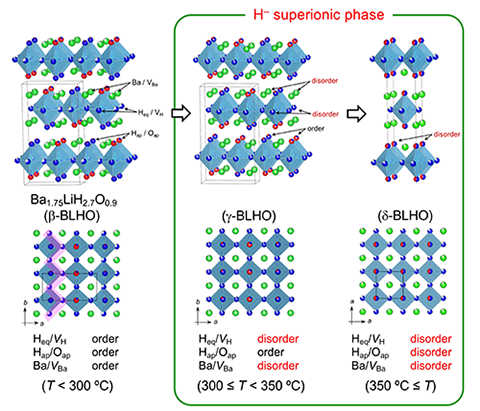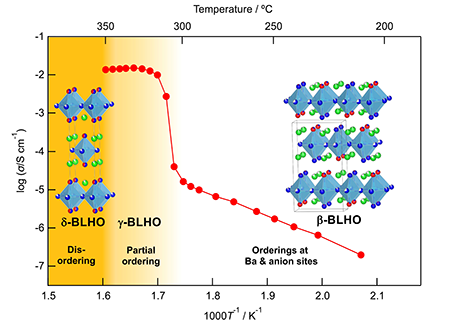English version 26 January, 2022 on EurekAlert!
An international research team developed a superionic conductor that negatively charged hydrogen, called hydride ions, diffuses fast.
------------------------------------------------------------------
Superionic conductors promise clean, renewable energy — at the right temperatures. These conductors, used as solid electrolytes in batteries and fuel cells, comprise solid materials in which ions move as fast as in liquids. One such superionic conductor is hydrogen, a clean energy source, which diffuses rapidly at low temperatures, but conductivity drops in the intermediate temperature range of 200-400 ºC, where chemical and energy conversions are more easily facilitated.
To better expedite hydrogen conductivity in the intermediate range, an international research team developed the first superionic conductor based on a negatively charged hydrogen atom, called a hydride ion.
The team published their results, which produced superior conductivity in the target range, on Jan. 13 in Nature Materials.
“Hydrogen transport in solids, applied in electrochemical devices, such as fuel cells and electrolysis cells, is key towards sustainable energy societies,” said paper author Genki Kobayashi, associate professor at the Institute for Molecular Science of the National Institutes of Natural Sciences in Japan. “The intermediate temperature range is ideal for fuel cells and electrochemical reactors because it enhances reactivity and eliminates or reduces rare metal catalysts. It is also the temperature at which industrial waste heat is released, making it a critical temperature range for waste heat utilization. However, there have been no solid electrolytes that can quickly diffuse hydrogen in this temperature range.”
Due to its structure in relation to its weight, the hydride ion possesses a low charge density, which weakens chemical bonds. As such, when hydride ions exist in solids, they diffuse in the material. This basic characteristic is favorable for fast ion conduction in general, but especially in solids, according to Kobayashi.
To achieve the hydride superionic conductivity, the researchers synthesized the oxyhydride, Ba1.75LiH2.7O0.9 (BLHO), which has a layered structure of Barium, Lithium, Hydrogen and Oxygen. The key, Kobayashi said, was to form the conduction layer by ordering hydride ions with negatively charged oxygen ions to introduce highly concentrated vacancies.

Figure 1. Crystal structures of H– superionic conductor, Ba1.75LiH2.7O0.9, and the phase transition behavior with elevating temperature. Green, blue, red, light blue, and white balls are corresponding to Ba, H, O, Li, and vacancy, respectively. At low temperatures, the localized vacancies inhibit the long-range diffusion (conductivity) of H–. After the phase transition, the vacancies delocalize, and the fast diffusion of H– is realized.
“BLHO has a high conductivity and low activation energy, achieved through a phase transition,” Kobayashi said, explaining that these properties only appear when BLHO is heated to a sufficiently high threshold temperature at which this phase transition occurs (Fig. 1). “Once it reaches that transition state, the conductivity of BLHO remains high and essentially independent of temperature in the intermediate range of 300-350°C (Fig. 2). Such a remarkable conductivity behavior at intermediate temperatures is anticipated to be significant step forward for energy and chemical conversion devices.”
While BLHO’s targeted conductivity remains high above 200°C, the low end of the intermediate temperature range, Kobayashi cautioned that more work is needed to stabilize the conductivity at lower temperatures.
“By stabilizing the high temperature phase of BLHO, we aim to develop hydride ion conductors that can operate as solid electrolytes from room temperature to intermediate temperature,” Kobayashi said. For their goal, the researchers hope to create novel energy storage devices and electrochemical reactors that utilize the charge flexibility of hydrogen.

Figure 2. The temperature dependence of H– conductivity for BLHO. After the β-γ transition, the conductivity drastically enhances, and its value is nearly independent of temperature. The conductivity increases by three orders of magnitude through the phase transition.
Kobayashi is also affiliated with The Graduate University for Advanced Studies, SOKENDAI. Other contributors include Fumitaka Takeiri, Akihiro Watanabe, Kei Okamoto, Asad Ali, Yumiko Imai and Masako Nishikawa, Department of Materials Molecular Science, Institute for Molecular Science; Masao Yonemura, Takashi Saito, Kazutaka Ikeda, Toshiya Otomo and Takashi Kamiyama; The Graduate University for Advanced Studies, SOKENDAI, and Institute of Materials Structure Science, High Energy Accelerator Research Organization (KEK); Ryoji Kanno, Department of Chemical Science and Engineering, School of Materials and Chemical Technology, and the Research Center for All-Solid-State Battery, Institute of Innovative Research, Tokyo Institute of Technology, Japan; Dominic Bresser and Sandrine Lyonnard, Université Grenoble Alpes, CEA, CNRS, IRIG, SyMMES, France; and Bernhard Frick, Institut Laue-Langevin, France.
Takeiri, Okamoto, Ali, are also associated with The Graduate University for Advanced Studies, SOKENDAI. Watanabe is also affiliated with the Department of Chemical Science and Engineering, School of Materials and Chemical Technology, Tokyo Institute of Technology. Bresser is also affiliated with the Karlsruhe Institute of Technology and the Helmholtz Institute Ulm in Germany.
Information of the paper
Journal Name: Nature Materials
Journal Title: Hydride-ion-conducting K2NiF4-type Ba-Li oxyhydride solid electrolyte
Authors: Fumitaka Takeiri, Akihiro Watanabe, Kei Okamoto, Dominic Bresser, Sandrine Lyonnard, Bernhard Frick, Asad Ali, Yumiko Imai, Masako Nishikawa, Masao Yonemura, Takashi Saito, Kazutaka Ikeda, Toshiya Otomo, Takashi Kamiyama, Ryoji Kanno, and Genki Kobayashi
DOI: 10.1038/s41563-021-01175-0
Financial Supports
The Japan Science and Technology Agency (JPMJPR1295), the Japan Society for the Promotion of Science (15H05497, 17H05492, 17H06145, 18H05516, 18H05518, 19H04710, and 20H02828) and the Advanced Research Program for Energy and Environment Technologies from the New Energy and Industrial Technology Development Organization (16823906) supported this research.
Contact Person
Genki Kobayashi
TEL: +81-564-55-7440
E-mail: gkobayashi_at_ims.ac.jp (Please replace the “_at_” with @)
1600


